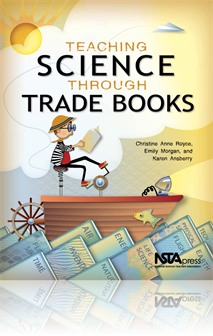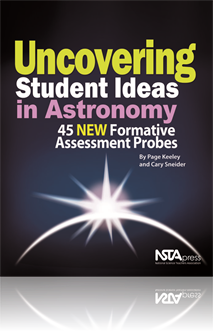All Book Chapters
Book Chapter
Water is an extraordinary substance that we often take for granted. Not only is it what makes our planet uniquely habitable, water is the only substance on Earth that naturally occurs in three different forms. In this chapter, students will explore s...
Book Chapter
The kitchen is a wondrous place for children to make observations and explore the basics of chemistry. Seize the opportunity and help students build process skills while cooking or baking. Almost everything we eat and certainly everything that is com...
Book Chapter
From a tiny radish seed to a giant coconut, seeds come in a multitude of shapes and sizes. They all share one amazing secret: the potential to grow into a new plant when conditions are right. In this chapter, students observe a variety of seeds, matc...
Book Chapter
Walk through any elementary school in the fall and you are bound to see students learning about pumpkins. Kids of all ages are fascinated by these versatile, edible members of the gourd family. Pumpkins are interesting and inexpensive and can be foun...
Book Chapter
Summer means flowers are in bloom! Each flowering plant produces a unique bloom that provides opportunities for students to make observations about plants. By comparing and contrasting flowers, students can connect their learning to the larger pictur...
Book Chapter
Students often become wistful for summer once the school year starts. Why not initiate a seashell classification activity to rekindle their interest in science and learning! Children love to handle and examine shells at any time of the year—with th...
Book Chapter
Triops, also called tadpole shrimp, are tiny aquatic animals that are easy to raise and fun to watch. Their rapid growth rate, underwater acrobatics, and entertaining feeding behaviors make these inexpensive and readily available animals well-suited ...
Book Chapter
Why, what, and how: Three words that young students often speak when they are full of questions about activities and experiences in their daily lives. Helping students clarify their thought processes and ask a question that can be answered through sc...
Book Chapter
“You can’t see me” is a popular childhood taunt, and although young children may not understand that hiding in plain sight does not conceal them, it does connect with a lesson about camouflage. In this chapter, students will learn that camoufla...
Book Chapter
Animals have many adaptations that help them survive in their environment and meet their special needs of food and shelter. This chapter focuses on two such adaptations: camouflage and beaks. ...
Book Chapter
The migration patters of animals have long been a source of wonder and awe. From the 6-mile journey of the army ants in the rain forests of Costa Rica, to the 20,000-mile journey of the sperm wale thought the world’s oceans, these animals’ abilit...
Book Chapter
Owls are fascination birds of prey. These nocturnal hunters are sometimes heard but rarely seen, making them even more intriguing and mysterious. These lessons feature two stories about owls. In both lessons, students dissect owl pellets to learn mor...
Book Chapter
We all have our own habitats, and this chapter students spend time thinking about what other organisms need to survive, what types of habitats they live in, and how to set up a habitat for a classroom animal....
Book Chapter
Kids today have a dizzying array of food choices, but choosing healthily is a challenge. Making wise choices is essential in maintaining a healthy lifestyle. This chapter's topic of healthy foods fits into science nicely when students start to consid...
Book Chapter
The human body is amazing! This chapter's trade books help students understand their growing bones, muscles, and joints while engaging in some investigations to help them become aware of their bodies and how exercise helps their bodies stay strong....
Book Chapter
It's a fact: kids today are less fit than they were only a generation ago. Many are showing early signs of cardiovascular risk factors such as physical inactivity, excess weight, and higher blood cholesterol. Now more than ever, it is important to ...
Book Chapter
Give a child a hand lens or a microscope and they quickly become fascinated with the hidden worlds these tools reveal. The lessons in this chapter provide opportunities for students to take a closer look at the properties of objects and organisms and...
Book Chapter
“You’ve got cooties!” is a traditional taunt between children on the playground. Although children’s avoidance of “boy or girl” germs is not scientifically based, students have an innate understanding that transmission of germs can happen...
Book Chapter
Children are naturally curious about the world around them, including the rocks beneath their feet. By observing, describing, and sorting a variety of rocks, students can discover that rocks have certain physical properties by which they can be class...
Book Chapter
“What type of rock is this?” is a common question spoken by all children at some point in their young lives. Many students have rocks of all shapes and sizes in their “collections.” In this chapter, young students will have the opportunity to...
Book Chapter
Have you ever played in the dirt? Repotted a plant? Planted a garden? In each and every one of these activities, you touched something that is a valuable resource in our lives—dirt! This chapter has students investigating different aspects of somet...
Book Chapter
Dinosaurs and the prehistoric age captivate children. At a young age, children can often cite facts and information about various dinosaurs, even if they do not yet understand the connection between dinosaurs and the way scientists gather information...
Book Chapter
Paleontologists, scientists who study the history of life on Earth, work in a dynamic area of science. Think of putting together a jigsaw puzzle with most of the pieces missing—that’s what creating the fossil record is like. Each time a new piece...
Book Chapter
Believe it or not, there is a 100% chance that an earthquake will happen somewhere in the world today. Although many of us think of Earth as solid ground, the crust is always moving. Most earthquakes are too small to feel, but we know they happen bec...
Book Chapter
The topic of natural disasters provided many avenues for students to delve into existing data and conduct research. The activities described in this chapter involve students in uncovering information about previous natural disasters or events to cons...
Book Chapter
Weather is a topic in science that is applicable to our lives on an everyday basis. The weather often determines what we wear, where we go, and what we do. The activities here focus on clouds and the part they play in determining our weather. In the...
Book Chapter
Students probably have heard weather-based sayings, such as “March comes in like a lion and goes out like a lamb” or “April showers bring May flowers.” Throughout the ages, people have developed these and other sayings to try to predict what ...
Book Chapter
Can you measure a dog’s tail in dog biscuits? Can you measure a desk without a ruler? Which is better: measuring a room in paces or meters? Which system of measurement do scientists use? This chapter explores these questions and more to help learne...
Book Chapter
The next time you watch the Sun rise; take a minute to think about what’s really going on. You are standing on a giant ball of rock that is hurtling through space, and the spot where you are standing is rotating in the direction of a star 93 millio...
Book Chapter
From the time they are very young, children are naturally curious about the Moon. They may wonder about the different shapes of the Moon when they look up at the night sky. In this chapter's primary lesson, students discover through direct observatio...
Book Chapter
The winter months are a great time to make observations of several familiar constellations. While there’s no scientific reason to “know” the constellations—they are simply imaginative pictures imposed on stars—studying constellations can he...
Book Chapter
Just as words can tell a story, so can graphs. Pick up a newspaper or magazine and you will probably see several articles accompanied by graphs. Graphs are useful because they communicate information visually and can usually be read more quickly than...
Book Chapter
Taking Note of Natural Resources
The idea of “going green” or being aware of and reducing our impact on natural resources is receiving a lot of attention these days. Schools are starting to employ “green” practices and are soliciting help from the students to be aware of and...
Book Chapter
A notebook is perhaps the single most important piece of equipment a naturalist takes into the field. But notebooks are not only for use by field scientists: They are also excellent tools for helping students record observations outdoors, develop com...
Book Chapter
Many children have seen circus performers walk a tightrope, and they gaze with awe at their skill and ability to keep their balance and not fall from great heights. The allure of walking a tightrope and the science of balance behind it is the focus o...
Book Chapter
The purpose of this assessment probe is to elicit students’ ideas about the shape of the Earth. The probe is designed to find out how students reconcile the idea that the Earth is round, represented by the globe that they are taught about in school...
Book Chapter
The purpose of this assessment probe is to elicit students’ ideas about relative size. The probe is designed to find out how large students think the Earth is compared with the Sun. ...
Book Chapter
The purpose of this probe is to elicit students’ ideas about the changing length of daylight with the change in seasons. The probe is designed to find out if students can relate the apparent path of the Sun as seen from Earth to the length of dayli...
Book Chapter
The purpose of this assessment probe is to elicit students’ ideas about why the constellations change with the seasons. The probe is designed to find out how students use the Earth’s spin and orbit to explain why different constellations are visi...
Book Chapter
The purpose of this assessment probe is to elicit students’ ideas about when we can see the Moon. The probe is designed to reveal whether students recognize that the Moon can be seen at different times during the daylight hours as well as at night...




